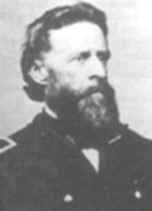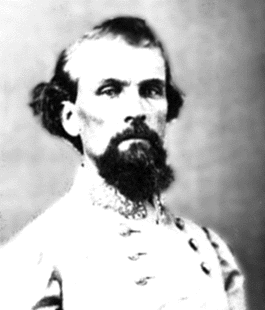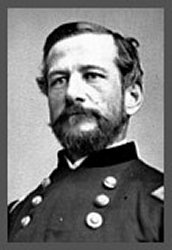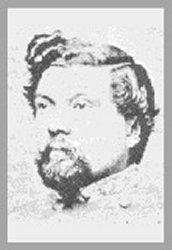

|
This page is dedicated to images of cavalry leaders who proved to be important to the outcome of the war. |
|
 |
Federal Cavalry Commanders: Federal Cavalry Commander Philip H Sheridan (1831-1888) [on the left] with some of his young Cavalry Generals |
| Philip St. George Cooke - "The Father of the United States Cavalry" (1809-1895) The tactical master of modern 19th-century mounted forces was Philip St. George Cooke. Cooke wrote a cavalry tactics manual just prior to the Civil War that became the training and fighting textbook for American troopers from both sides. Cooke's manual would be used in conjunction with an instruction manual titled "Instructions for Officers on Outpost and Patrol Duty," required reading for all cavalry officers as early as September 1861. |
 |
 |
General John Buford, USA (1826-1863) On the first day of the Battle of Gettysburg only the Cavalry of Buford's command was available to make a stand against the oncoming Confederates. Buford dismounted his cavalrymen, positioned his horse artillery, and kept the Confederates from occuppying the high ground south of the town. Many historians consider Buford's holding action on the first day to have been the key to the battle for the Federals. Buford was portrayed by Sam Elliott in the movie "Gettysburg." |
| General Wade Hampton, CSA (1818-1902) General Wade Hampton is our VIP Mounted History subject of the month. Enter the Cavalry Home page entrance to learn more about him, OR CLICK ON HIS IMAGE AT THE RIGHT. The book is available on Kindle. BOOK AVAILABLE on AMAZON.COM and Kindle |
|
 |
Confederate Cavalry Corps Commander James Ewell Brown [JEB] Stuart, (1833-1864) It can be argued that Stuart was the finest cavalry commander of the war. He rode around the Federal Army three times during the course of the war. On the 1863 raid, he failed to meet with General Robert E. Lee at Gettysburg, PA, and has been held responsible, by some historians, for Lee's defeat. He was killed at the Battle of Yellow Tavern in 1864 by a pistol bullet fired by Private John A. Huff of Co. E, 5th Michigan Cavalry. His loss was a blow to the South. |
| General Nathan Bedford Forrest, CSA, (1821-1877) Uneducated but not illiterate, Nathan Bedford Forrest was a natural tactician who earned the praise of his enemies. Both Grant and Sherman feared this man ("that devil Forrest") who entered the Confederate forces a private and left a general. The stories of him are legend. Historian Shelby Foote noted, "In his first fight... the forty year old Forrest improvised a double envelopment, combined it with a frontal assault -- classic maneuvers which he could not identify by name and of which he had most likely never heard." Forrest is said to have killed more men in single combat (26) than any other general officer of the Civil War. He had 29 horses shot out from under him in battle. His unfortunate involvement in the massacre of Black Federal soldiers at Fort Pillow and his founding of the Klan have considerably tarnished his well-deserved military reputation. |
 |
 |
Cavalry Commander of the Army of the Potomac, Maj. General Alfred Pleasonton, USA (1824-1897) A graduate of West Point in 1844, Pleasonton served in the Mexican War and on frontier duty. In August 1861 he was a Captain in the 2nd US Cavalry. He was promoted Major for the Peninsula campaign, and in July 1862 was appointed Brig. Gen. of Volunteers. He commanded 2nd Bde./Cavalry Divn. of Army of the Potomac, commanded the Cavalry Corps at South Mountain, Antietam, Fredericksburg, and commanded 1st Divn./Cavalry Corps at Chancellorsville. In June 1863 he was promoted Maj. Gen. of Volunteers and commanded the Cavalry Corps at Brandy Station and in the Gettysburg campaign. While in command of the District of St Louis he suppressed Scott Price's raid and ended all resistance west of the Mississippi. He resigned in 1868. |
| Brevet Brigadier General George A. Custer, USA (1836-1876)
BOOK AVAILABLE on AMAZON.COM and Kindle |
|
|
|
Major General Thomas L. Rosser, CSA (1836-1910) Rosser entered West Point in 1856, but resigned before graduation in April 1861 in order to join the Confederate Army as an artillery instructor with the rank of 1st Lieutenant. He fought at First Manassas and in the Peninsula campaign. In May 1862 he became Colonel of 5th Virginia Cavalry. He was wounded at Mechanicsville and in September 1863 was promoted Brig. General in command of the Laurel Brigade which contained many of the best cavalry regiments in the south. He fought in the 1864 Shenandoah Valley campaign and was made Maj. General. He raided into West Virginia for the rest of 1864-1865, and escaped the surrender at Appomattox. |
|
Maj. General George Stoneman, USA (1822-1894) |
 |



